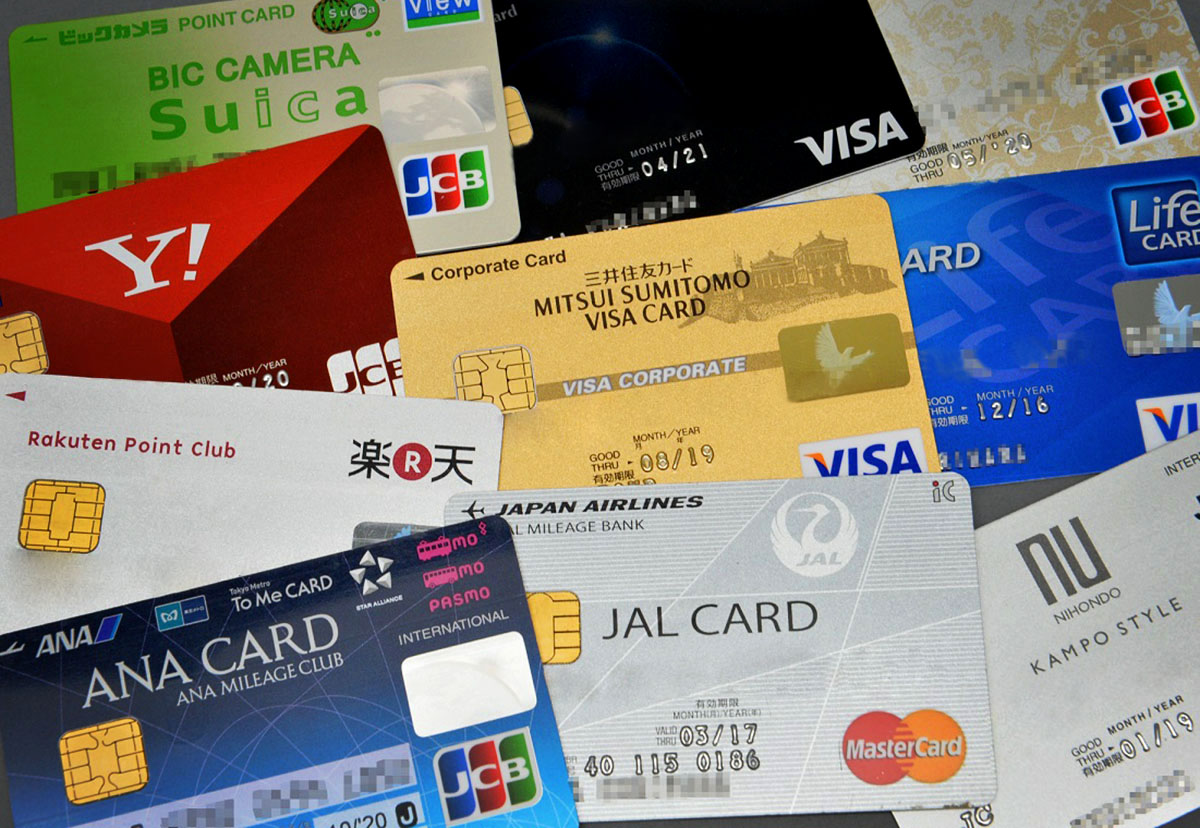

Finance
How To Get A Joint Credit Card
Modified: January 7, 2024
Learn how to get a joint credit card and manage your finances together. Take control of your financial future with our expert tips and advice.
(Many of the links in this article redirect to a specific reviewed product. Your purchase of these products through affiliate links helps to generate commission for LiveWell, at no extra cost. Learn more)
Table of Contents
Introduction
Welcome to the world of joint credit cards! If you’re looking for a convenient way to manage finances with a partner, family member, or business partner, a joint credit card could be the perfect solution. A joint credit card allows two or more individuals to share a single credit card account with the ability to make purchases and manage expenses together.
In this article, we will explore the ins and outs of joint credit cards, the benefits they offer, key factors to consider before getting one, and tips for maximizing their advantages. Whether you’re considering getting a joint credit card with your spouse, parent, sibling, or business partner, this guide will provide you with the necessary information to make an informed decision.
Joint credit cards can open up a world of possibilities for shared spending and budgeting. They offer convenience, flexibility, and transparency, making it easier to collaborate and stay on top of your financial goals. However, it’s important to approach this decision with careful consideration to ensure that a joint credit card is the right choice for your unique circumstances.
Throughout this article, we will delve into the various aspects of joint credit cards, including the application process, managing finances and payments, and tips for making the most of your card. By the end, you will have a comprehensive understanding of joint credit cards and be equipped with the knowledge to make an informed decision about whether this type of credit card is right for you.
Understanding Joint Credit Cards
Joint credit cards are credit card accounts that are shared between two or more individuals. Unlike having separate credit cards, a joint credit card allows all account holders to use the same card and access the same line of credit. This can be particularly beneficial for partners, married couples, family members, or business partners who want to consolidate their spending and manage their finances together.
With a joint credit card, all account holders are equally responsible for the charges made on the card. This means that any purchases, payments, or debts incurred on the joint credit card are the collective responsibility of the cardholders. It’s important to note that the credit history of all account holders will also be affected by the way the joint credit card is managed.
One of the key benefits of joint credit cards is that they provide transparency and accountability. All account holders can easily track the spending and transactions made on the card, making it simpler to manage finances and budgets together. This can be especially helpful for couples or partners who want to have a clear overview of their shared expenses and financial goals.
It’s also worth noting that joint credit cards typically offer additional features like rewards points, cashback programs, and other perks that can benefit all account holders. By pooling your spending on a joint credit card, you can accumulate rewards points more quickly and enjoy the benefits collectively.
However, it’s important to understand the potential risks and considerations associated with joint credit cards. Since all account holders are equally responsible for the debt, any missed payments or high balances can negatively impact everyone’s credit scores. Additionally, if one account holder misuses the card or accumulates significant debt, it can strain the relationship and create financial difficulties for all parties involved.
Before deciding to open a joint credit card, it’s crucial to have open and honest discussions about financial habits, budgets, and individual responsibilities. Clear communication and shared goals are key to successfully managing a joint credit card and ensuring that it benefits all account holders.
Now that you have a better understanding of joint credit cards, let’s explore the various benefits they offer and why they may be the right choice for managing your finances with a partner or family member.
Benefits of Joint Credit Cards
Joint credit cards offer several advantages that make them an appealing option for individuals who want to share expenses and manage finances together. Here are some of the key benefits of joint credit cards:
- Convenience and Shared Expenses: A joint credit card allows you and your partner or family member to consolidate your spending and have a single card for shared expenses. This can make it easier to keep track of purchases, manage budgets, and split bills.
- Transparency and Accountability: With a joint credit card, all account holders have access to the card’s transaction history, statements, and payment details. This transparency allows for better financial management, as all parties involved can easily monitor and discuss expenses.
- Building Credit Together: By using a joint credit card responsibly and making timely payments, all account holders can contribute to building a positive credit history. This can be particularly beneficial for individuals who are starting to build their credit or want to improve their credit scores.
- Efficient Budgeting: Joint credit cards allow for shared budgeting, making it easier to track expenses and allocate funds for different categories. This can help couples or family members stay on top of their financial goals and ensure that spending is aligned with their budgetary plans.
- Shared Rewards and Perks: Many joint credit cards offer rewards programs, cashback options, and other perks. By pooling your spending on a joint credit card, you can accumulate rewards points faster and enjoy the benefits collectively.
- Easier Expense Splitting: When it comes to shared expenses, such as groceries, bills, or travel expenses, having a joint credit card simplifies the process of splitting the costs. This eliminates the need for reimbursement or keeping track of who paid for what.
- Financial Partnership: A joint credit card fosters a sense of financial partnership and shared responsibility. It encourages open communication about money matters, helping individuals work together towards their financial goals.
While the benefits of joint credit cards are numerous, it’s essential to consider specific factors before deciding to open a joint credit card account. In the next section, we will explore some key considerations that should be taken into account before moving forward.
Factors to Consider Before Getting a Joint Credit Card
While joint credit cards offer many benefits, it’s important to carefully consider certain factors before deciding to open a joint credit card account. Here are some key considerations:
- Trust and Communication: A joint credit card requires a high level of trust and open communication between all account holders. It’s crucial to have open and honest discussions about financial habits, budgeting, and spending priorities to ensure that everyone is on the same page.
- Financial Goals: Before getting a joint credit card, it’s essential to align your financial goals with the other account holders. Discuss your short-term and long-term goals, such as saving for a house or paying off debts, to ensure that a joint credit card is compatible with your shared financial objectives.
- Credit History: It’s important to assess the credit history of all account holders before applying for a joint credit card. If one account holder has a poor credit history or a low credit score, it could impact the chances of approval for the joint credit card or result in higher interest rates.
- Spending Habits: Consider the spending habits of each account holder. Are there any discrepancies in spending patterns or financial responsibility? It’s important to be aware of any potential differences and address them openly to avoid conflicts in the future.
- Joint Liability: With a joint credit card, all account holders are jointly responsible for any debt incurred on the card. This means that if one person fails to make timely payments, it can negatively affect the credit scores of all account holders. It’s crucial to trust each other’s financial responsibility and discuss how you will handle payments and manage the card together.
- Exit Strategy: While no one wants to think about the possibility of a relationship or partnership ending, it’s essential to have an exit strategy in place. Discussing how you will handle the joint credit card in case of separation or dissolution of the partnership can save you from potential financial headaches down the line.
- Legal and Financial Implications: Consider consulting with a legal or financial advisor to understand the legal and financial implications of having a joint credit card. They can provide guidance on potential risks, responsibilities, and legal binding aspects of the joint credit card.
By carefully considering these factors, you can make an informed decision about whether a joint credit card is the right choice for you and your financial partnership. Next, we will explore the application process for getting a joint credit card.
How to Apply for a Joint Credit Card
Applying for a joint credit card is a straightforward process. Here are the steps to follow:
- Research and Comparison: Begin by researching different credit card issuers and comparing their offerings. Look for joint credit cards with features that align with your financial goals and spending habits.
- Gather Required Information: Before starting the application process, gather the necessary information for all account holders. This typically includes personal identification documents, social security numbers, income details, and employment information.
- Choose an Issuer: Once you’ve identified a suitable credit card, visit the issuer’s website or contact their customer service to inquire about their joint credit card options. They will provide you with the necessary application forms and guidance.
- Complete the Application: Fill out the joint credit card application with accurate and up-to-date information for all account holders. Provide details about income, employment, and any other requested information.
- Submit the Application: After completing the application, submit it to the credit card issuer for review. Make sure to double-check all the information provided to avoid any errors or discrepancies.
- Wait for Approval: The credit card issuer will review the joint credit card application and make a decision. The approval process typically takes a few days to a few weeks. It’s important to be patient during this time.
- Activate the Card: If approved, you will receive the joint credit card in the mail. Follow the instructions provided to activate the card before using it for any purchases or payments.
Remember, the application process and requirements may vary slightly depending on the credit card issuer. It’s always best to reach out to the issuer directly or visit their website to get the most accurate and up-to-date information.
Once you have successfully obtained a joint credit card, managing finances and payments becomes crucial for a smooth experience. In the next section, we will provide tips on how to effectively manage your joint credit card and avoid potential pitfalls.
Managing Finances and Payments with a Joint Credit Card
Proper management of finances and payments is essential when it comes to joint credit cards. Here are some tips to help you effectively manage your joint credit card:
- Establish Clear Communication: Open and honest communication between all account holders is key to successfully managing a joint credit card. Regularly discuss expenses, budgets, and financial goals to ensure everyone is on the same page.
- Set a Spending Limit: Establish a spending limit or budget for the joint credit card to prevent overspending. This will help you stay within your means and avoid accumulating excessive debt.
- Monitor Transactions: Regularly review the transactions made on the joint credit card. This can be done by accessing online banking or credit card statements. Keep an eye out for any unauthorized charges or discrepancies.
- Make Timely Payments: Consistently making on-time payments is crucial for maintaining a good credit score and avoiding late payment fees. Create a system to ensure that payments are made promptly each month.
- Automate Payments: Consider setting up automatic payments for the joint credit card. This can help prevent missed payments and ensure that the minimum payment is always made on time.
- Review Statements Together: Sit down with all account holders and review the credit card statements regularly. This provides an opportunity to assess spending patterns, identify areas for improvement, and discuss any concerns or issues.
- Share Responsibility Equally: Each account holder should take equal responsibility for managing the joint credit card. Distribute tasks such as paying the bills, monitoring transactions, and reconciling statements to ensure fair and shared involvement.
- Address Disagreements Promptly: If disagreements arise regarding expenses or finances, address them promptly and openly. Find a compromise or alternative solution that works for all parties involved.
- Keep Track of Rewards and Benefits: Take advantage of any rewards programs or benefits offered by the joint credit card. Monitor the accumulated rewards and redeem them when it makes sense for your shared goals.
- Regularly Evaluate the Arrangement: Periodically reassess your joint credit card arrangement to ensure that it still aligns with your financial needs and goals. If circumstances change or conflicts arise, discuss potential adjustments or alternatives.
By following these tips and maintaining a proactive approach to managing your joint credit card, you can enjoy the benefits and convenience it offers while maintaining financial harmony.
Next, let’s explore some additional tips for maximizing the benefits of a joint credit card.
Tips for Maximizing the Benefits of a Joint Credit Card
To make the most of your joint credit card and fully maximize its benefits, consider the following tips:
- Align Financial Goals: Ensure that all account holders are on the same page when it comes to financial goals. Discuss and establish shared objectives such as saving for a specific purchase or paying off debt.
- Designate Responsibility: Assign specific responsibilities to each account holder, such as tracking expenses, making payments, or managing rewards. This promotes accountability and prevents confusion or missed tasks.
- Maximize Rewards: Take advantage of the rewards and benefits offered by the joint credit card. Research the program details and make intentional choices to earn as many rewards points or cashback as possible.
- Use Credit Wisely: Make conscious decisions about when and how to use the joint credit card. Avoid unnecessary or impulsive purchases, and utilize the card for planned expenses that align with your shared financial goals.
- Regularly Review Statements: Make it a habit to review credit card statements with all account holders. This not only helps spot any discrepancies but also allows for a deeper understanding of spending patterns and opportunities for improvement.
- Track Expenses: Use budgeting tools or apps to track your joint expenses and monitor your progress towards financial goals. This helps identify areas for adjustment and ensures that you stay within your budget.
- Keep Communication Open: Continuously communicate with all account holders about any changes or concerns regarding the joint credit card. Regularly discuss financial matters and reevaluate the arrangement as needed.
- Manage Credit Utilization: Keep your credit utilization ratio in check by not maxing out your joint credit card. Aim to use only a portion of the available credit to maintain a healthy credit score.
- Educate Yourself: Stay informed about credit card terms, fees, and policies. Familiarize yourself with the terms and conditions of your joint credit card to make informed decisions and avoid any surprises.
- Plan for Emergencies: Discuss and establish a plan for handling emergency situations. Prepare for unexpected expenses and potential financial hardships to ensure you have a strategy in place.
By implementing these tips, you can not only optimize the benefits of your joint credit card but also strengthen your financial partnership and achieve your shared financial goals.
Now that we’ve explored the various aspects of joint credit cards and provided valuable tips for managing and maximizing their benefits, let’s wrap up this article.
Conclusion
Joint credit cards can be a powerful tool for couples, family members, or business partners looking for a convenient way to manage their finances together. By sharing a single credit card account, all account holders can enjoy the benefits of convenience, transparency, and simplified expense management.
Throughout this article, we have discussed the importance of understanding joint credit cards, including their benefits and factors to consider before getting one. We explored the application process and provided tips for effectively managing joint credit cards, as well as maximizing their benefits.
When considering a joint credit card, it’s crucial to prioritize trust, communication, and shared financial goals. Open and honest conversations about spending habits, responsibilities, and potential challenges are essential for a successful joint credit card arrangement.
Remember to regularly review transactions, establish a clear system for making payments, and keep track of rewards and benefits. By actively managing your joint credit card, you can minimize potential conflicts and make the most of the convenience and advantages it offers.
Ultimately, joint credit cards can be a valuable tool for fostering financial partnership and achieving shared financial goals. However, it’s important to approach this decision with careful consideration and ongoing communication. By doing so, you can leverage the benefits of a joint credit card and strengthen your financial collaboration.
Now that you have a comprehensive understanding of joint credit cards and the best practices for managing them, you can confidently explore the option of getting a joint credit card and embark on a successful financial journey together.














